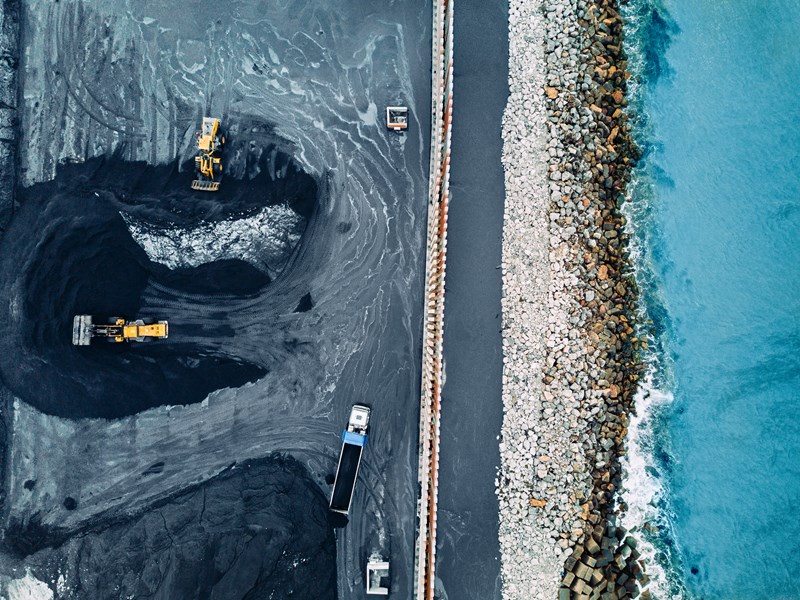Are miners ready for a net zero future?
How the industry is facing up to the decarbonisation challenge
3 minute read
James Whiteside
Head of Corporate, Metals & Mining

James Whiteside
Head of Corporate, Metals & Mining
With 15 years of experience in the metals and mining industry, James leads our corperate coverage.
Latest articles by James
-
Opinion
The end of capital discipline in mining?
-
The Edge
Big Mining pivots to copper for growth
-
Featured
Metals & mining 2025 outlook
-
Opinion
Battery power play: countercyclical opportunities in raw materials
-
Opinion
Copper rush: A strategic analysis
-
Opinion
PPAs: transforming miners’ decarbonisation strategies
Miners are facing greater pressure than ever to cut emissions. Achieving an energy transition that limits the rise in global temperatures to below 2 degrees requires huge policy shifts – and could also drive change in company portfolios.
Earlier this year, we published a pathway to net zero for the mining sector, setting out the scale of the challenge. But is the industry on course? In a recent webinar, we examined the policies and operations of the five largest diversified miners – Anglo American, BHP, Glencore, Rio Tinto and Vale – to see how they are making headway and where the key challenges lie.
Got an hour? Fill in the form to listen to the full replay. We’ll also send you a copy of the presentation slides. Got five minutes? Read on for a summary of some of the main themes.
Targets – are miners aiming high enough?
Most of the five diversified miners aim to be carbon neutral by 2050 for scope 1 (direct) and scope 2 (purchased electricity, heat, and steam) emissions. Only Anglo American stands out, aiming for neutrality by 2040.
Break down company ambitions and there’s a wide range of goals. Companies vary on a number of factors, not least whether to measure absolute emissions, carbon intensity – or both.
The toughest challenge for miners is how they tackle emissions further downstream. Scope 3 targets, which include transportation and downstream processing, make up by far the highest proportions of their carbon footprints. These emissions are much harder to measure.
Glencore has already committed to reducing its Scope 3 emissions by 30%, while Vale is set to follow suit. But even those not setting targets acknowledge the growing urgency of this important aspect.
Focusing on absolute emissions, or carbon intensity – what are the preferred measures among the largest miners? Fill in the form at the top of the page to watch the webinar replay, or read on for more on the key themes.

Portfolio construction – company commodity strategies are evolving
How each company approaches its metals and mining portfolios will have a substantial impact on their path to net zero.
Our 2030 revenue projections , based on current portfolios, show that steel raw materials – iron ore and metallurgic coal – still dominate. However, looking at company’s stated mined commodity objectives, the prevalence of energy transition commodities is increasing.
Transition materials, those metals playing a major role in clean energy development, such as battery technology, are a factor in all five of the diversified miners’ portfolios. Glencore is weighting capex towards African-sourced copper, as well as cobalt and nickel from Canada. Vale’s focus is on high-grade iron ore and class-1 nickel.
M&A activity has in some cases had a short-term impact on scope 3 emissions. Could further disposals or acquisitions be on the cards if Scope 3 targets are adopted? Watch the webinar replay for more on past transactions and potential deals.
Power source – the energy behind net zero ambitions
As discussed in our pathway to net zero report, electrification – from renewable sources – is critical to shifting the dial on scope 1 and 2 emissions. So far though, the pace of adoption has been underwhelming.
By 2025, the International Council on Mining and Metals (ICMM) wants all underground equipment to switch to battery power. This move will protect workers by minimising diesel particular matter (DPM). Rolling out electrification to large-scale open-pit operations will be a steeper challenge. In these cases, the whole pit needs to be designed around electrification, in some cases including trolley assists and conveyor systems. For many, the up-front costs don’t yet justify the potential long-term cost savings, and in some cases, retrofitting is just not feasible.
Ultimately, economics – not emissions targets – drive decisions. As a result, what powers operations comes down to cost and convenience. In some cases, a hydro plant will be the lowest-cost option, elsewhere it makes more economic sense to source power from fossil fuels.
Rio Tinto has the highest proportion of renewable energy use of any of the diversified miners (having risen to more than 30% over the last five years). However, this year the company announced it was shutting it’s hydroelectric-powered aluminium smelter Tiwai Point in New Zealand, as energy costs proved too high. At the same time, the company will also use coal power for its Oyu Tolgoi copper mine in Mongolia, as part of a licensing arrangement with the Mongolian government.
Carbon pricing can bring parity between hitting emissions targets and the economics. The pace of progress will also depend on upgrades to the power grid.
How will changes to policy and the energy mix in key mining jurisdictions affect miners’ progress on the path to net zero? Watch the webinar replay to find out more.
Exploring technology to cut emissions
Progress to electrification may be slow but the industry is investing in decarbonisation. Increasing research and development is going to be critical for cutting emissions, in particular scope 3.
All the miners are exploring technology to tackle the problem and there is already a broad range under development. Anglo American aims to use hydrogen fuel cells at a platinum mine in South Africa, and at least one of its open-pit coal mines in Australia, which would drastically cut the level of emissions. Expanding the role for hydrogen is also in Anglo’s interests, as the electrolysers needed to produce hydrogen rely upon the platinum-group metals Anglo produces.
Meanwhile, both Glencore and BHP are exploring carbon capture utilisation and storage (CCUS) to partly offset the presence of metallurgical coal in their portfolios. These capture mine site emissions from fugitive methane, which is then burned for energy.
How far is mining from successful energy transition?
So, is the industry ready for a net zero future? Particularly given the challenges of tackling the Scope 3 emissions and decarbonising the entire value chain, the transition might seem some way off.
But companies have realised that they need to do more, whether that is amending their commodity strategies, finding cleaner energy sources, or innovating to reduce emissions. Indeed, even those diversified miners that have yet to set Scope 3 targets, are grappling with the emerging pressure to decarbonise. They know that failing to act risks their market becoming less competitive, and even the long-term threat of their product being substituted entirely.
Find out more
In 'The pathway to net zero for miners' James Whiteside and Julian Kettle, Vice Chairman, Metals & Mining, discuss:
- Our ‘cradle-to-gate’ methodology for assessing emissions throughout the mining value chain
- How carbon pricing will impact individual metals
- Which companies have the largest proportion of scope 3 emissions.








